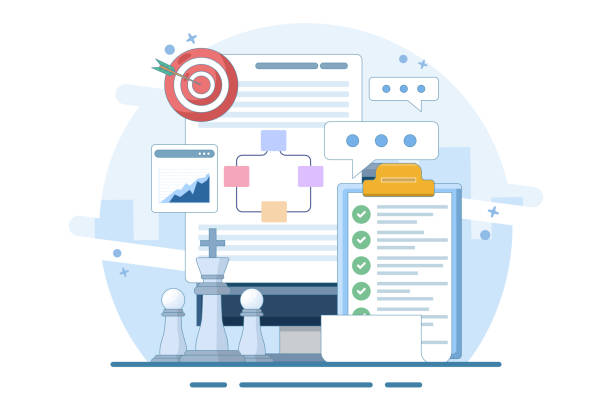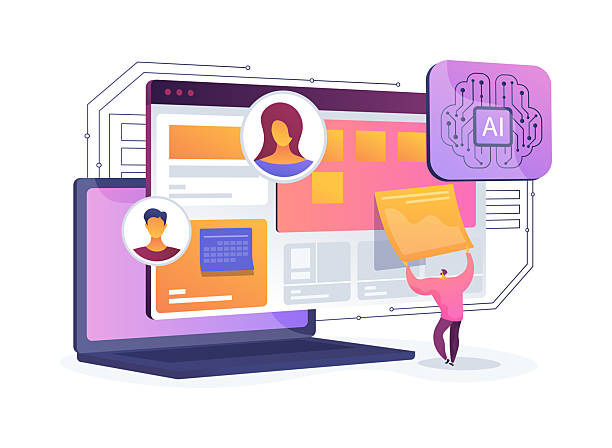Introduction to Secure Website Design and Its Importance

In today’s digital world, where businesses and individuals are increasingly reliant on the internet, the issue of #Website_Security has become more important than ever.
#Data_Protection and #User_Trust are two fundamental pillars upon which every website must be built.
Without a comprehensive approach to secure website design, sensitive data is put at risk, which can lead to loss of reputation, significant financial losses, and even legal issues.
An insecure website not only provides an opportunity for hackers and malware but also sends a negative signal to users that their information is not safe.
This significantly impacts user experience and ultimately the overall success of your platform.
For this reason, understanding and implementing the principles of secure website design should be a priority for every developer and business owner.
It is not just an option, but a necessity for survival in today’s challenging online environment.
Every aspect of a website, from initial coding to server configuration and database management, must be developed with security in mind.
In this article, we will deeply explore various dimensions of secure website design to ensure you have the necessary tools to build and maintain a secure digital presence.
These initial steps form the foundation of a strong defensive strategy against cyber attacks, protecting your valuable data and user trust.
Did you know that your company’s website is the first point of contact for 75% of potential customers?
Your website is the face of your brand. With **Rasaweb**’s corporate website design services, build an online presence that earns customer trust.
✅ Create a professional and lasting image for your brand
✅ Attract target customers and increase online credibility
⚡ Get a free consultation from **Rasaweb** experts!
Common Web Security Threats and How to Identify Them

To effectively implement secure website design, we must first become familiar with various types of cyber threats.
Web attacks are complex and constantly evolving.
One of the most common and dangerous attacks is SQL Injection, which allows an attacker to inject malicious SQL code into website input fields to access or even manipulate the database.
Another type is Cross-Site Scripting (XSS), where malicious client-side scripts (usually JavaScript) are injected into web pages and can steal user information or hijack their sessions.
Distributed Denial of Service (DDoS) is another major threat that overwhelms a server with massive traffic, rendering it unavailable.
In addition to these, there are attacks such as Cross-Site Request Forgery (CSRF), Broken Authentication, and Local File Inclusion (LFI), each of which can target different vulnerabilities in a website.
Identifying these threats requires a combination of automated security scanning tools and manual code review.
Periodic penetration testing and vulnerability assessments are crucial for discovering weaknesses before attackers find them.
This continuous process helps strengthen the secure website design approach and ensures that your defensive measures are always up-to-date and effective.
Understanding these threats is the first step towards building a strong and impenetrable defense system.
Basic Principles of Secure Website Design from Coding to Infrastructure

The foundation of secure website design is established from the very initial stages of coding and infrastructure architecture.
This is a shared responsibility among developers, system architects, and network administrators.
One of the most important frameworks in this area is OWASP Top 10, which identifies 10 critical web security vulnerabilities and provides solutions to prevent them.
Implementing Defense in Depth means applying multiple layers of security, so that if one layer fails, subsequent layers protect the system.
This includes server-side user input validation, using Prepared Statements to prevent SQL Injection, and Output Encoding to combat XSS.
At the infrastructure level, using Web Application Firewalls (WAF), secure server configuration, and separating services from each other are essential to limit the scope of intrusion in case of an attack.
Also, applying the Principle of Least Privilege means that each user or service only requires the minimum necessary access to perform their tasks.
Below is a table of the most common vulnerabilities and prevention methods, which serves as a practical guide for every developer and security engineer in securing websites.
These preventive measures form the backbone of a proactive approach to web security and protect the website from threats from the outset.
| Vulnerability | Description | Prevention Method |
|---|---|---|
| SQL Injection | Injecting malicious SQL code into the database | Using Prepared Statements, input validation |
| XSS (Cross-Site Scripting) | Injecting malicious scripts into web pages | Output Encoding, Content Security Policy (CSP) |
| Broken Authentication | Flaws in user authentication mechanisms | Strong passwords, MFA, secure session management |
| Insecure Deserialization | Exploiting the process of converting data to objects in code | Avoiding unsafe data, data integrity checks |
The Role of SSL/TLS Certificates in Securing Web Communications

One of the fundamental pillars of secure website design is the implementation of SSL/TLS certificates.
These certificates upgrade the HTTP protocol to HTTPS and create a cryptographic layer for communications between the user’s browser and the web server.
Without SSL/TLS, data such as passwords, credit card information, and other sensitive information are transmitted as plain text across the network, and any attacker who can eavesdrop on the traffic (Man-in-the-Middle Attack) will be able to access this information.
SSL/TLS certificates not only encrypt data but also authenticate the website’s identity.
This means users can be sure that they are indeed connected to their intended server and not a fake site created by an attacker.
There are various types of certificates, including Domain Validation (DV) which only verifies domain ownership, Organization Validation (OV) which also verifies the organization’s identity, and Extended Validation (EV) which has the most stringent validation and displays the company name in the address bar.
The choice of certificate type depends on the sensitivity of the information exchanged and the need for user trust.
Today, Google and other search engines prefer HTTPS-enabled websites in their rankings, which is another reason for the importance of SSL/TLS in website security.
Proper implementation of these certificates is an essential step for any website seeking to protect user privacy and its reputation in the online space.
Does your company’s website perform as befits your brand? In today’s competitive world, your website is your most important online tool. Rasaweb, specializing in professional corporate website design, helps you to:
✅ Gain customer credibility and trust
✅ Convert website visitors into customers
⚡ Get a free consultation!
Protecting Databases and User Information

The heart of any website that deals with user data is its database.
Therefore, protecting databases and user information is a critical aspect of secure website design.
One key measure is data encryption, especially for sensitive information such as passwords, credit card numbers, and identity data.
Encryption should be applied not only during transmission (with SSL/TLS) but also at rest.
Using strong encryption algorithms and securely managing encryption keys is of high importance.
Implementing strict access control over the database, meaning that only authorized users and applications can access specific data, is essential.
This also includes implementing the principle of least privilege for database users.
Furthermore, database firewalls and Intrusion Detection Systems (IDS) should be used to monitor suspicious activities and prevent unauthorized access.
Data minimization and regular deletion of unnecessary data can also reduce the risk of information exposure.
Regular and encrypted backups of the database, stored in secure and separate locations, are an essential solution for data recovery in case of an attack or disaster.
These backups must be periodically tested to ensure their integrity and recoverability.
Any flaw in database security can lead to catastrophic consequences, so investing in this part of website security is a strategic and vital decision.
Strong Access Management and Authentication

Strong access management and authentication are fundamental pillars in the secure website design approach.
The first step in this regard is to compel users to use strong and unique passwords.
This includes a combination of uppercase and lowercase letters, numbers, and symbols, as well as an appropriate password length.
Using strong hashing functions (such as bcrypt or scrypt) to store passwords in the database, instead of storing them as plain text, is crucial.
This prevents direct access by attackers to passwords even if the database is exposed.
In addition to strong passwords, implementing Multi-Factor Authentication (MFA) significantly enhances security.
MFA requires the user to prove their identity with more than one method, for example, with a combination of a password and a code sent to their mobile phone or a fingerprint.
This prevents unauthorized access even if the user’s password is stolen.
Access management systems should operate based on the “Principle of Least Privilege,” meaning that each user or system only has access to the resources they need to perform their tasks.
This principle limits the attacker’s scope of penetration in case of unauthorized access to a user account.
Also, Session Management must be carefully performed; this includes generating random and unpredictable session IDs, expiring sessions after a period of inactivity, and using secure cookies.
Monitoring authentication and access logs to identify suspicious patterns and intrusion attempts is also an important part of website security that must be continuously pursued.
Continuous Updates and Website Security Maintenance

After the initial implementation of secure website design, the work has just begun.
Security is a continuous process and requires continuous updates and website security maintenance.
Attackers are constantly looking for new vulnerabilities in software, operating systems, and frameworks.
Therefore, using old and outdated versions puts your website at serious risk.
Ensuring that all website components, including Content Management Systems (CMS) like WordPress or Joomla, plugins, themes, coding libraries, server operating systems, and even database software, are always updated to the latest stable and secure versions, is crucial.
Patch Management means applying security patches released by developers quickly and regularly.
These patches usually fix discovered vulnerabilities.
In addition to updates, regular and automated backups of all website data and code are essential.
These backups must be stored in a secure location separate from the main server and must be quickly and fully recoverable.
Continuous security monitoring using SIEM (Security Information and Event Management) tools and Intrusion Detection Systems (IDS/IPS) helps identify suspicious activities in real-time.
This proactive maintenance is an integral part of secure website configuration and ensures that your website remains resilient against new threats.
The table below shows important tools and security maintenance activities.
| Category | Tool/Activity | Description |
|---|---|---|
| Vulnerability Scanner | Nessus, OpenVAS | Automated scanning to discover security weaknesses |
| Web Application Firewall (WAF) | ModSecurity, Cloudflare WAF | Protection against Layer 7 web attacks |
| Log Monitoring | ELK Stack, Splunk | Analyzing security events through logs |
| Backup Management | rsync, Veeam, CMS plugins | Performing regular and tested backups |
| Penetration Testing (Pen-Testing) | Manual and automated tools | Simulating attacks to discover vulnerabilities |
Security Incident Response and Data Recovery

Even with the best approaches to secure website design and continuous maintenance, the likelihood of security incidents is not completely zero.
For this reason, having a comprehensive and predefined Security Incident Response Plan is a critical component of the overall cybersecurity strategy.
This plan should include specific steps for identification, containment, eradication, recovery, and lessons learned from incidents.
Identification means rapidly detecting intrusion or attack, which is done through continuous monitoring of logs, alerts, and intrusion detection systems.
The containment phase includes actions to limit the scope of the attack and prevent its spread, such as disconnecting infected servers or blocking attacker IP addresses.
Eradication means completely removing the intrusion agent, malware, or vulnerability through which the attack occurred.
After that, the data recovery and service restoration phase begins, which involves recovering from healthy backups, rebuilding systems, and ensuring their correct operation.
Finally, lessons learned from incidents involve root cause analysis of the attack and implementing necessary measures to prevent its recurrence in the future.
Training teams, conducting periodic drills to test the incident response plan, and continuously updating it based on new experiences are vital for strengthening website security capability in facing challenges.
This preparedness makes the difference between a minor security breach and a major disaster.
Research shows that 80% of customers trust companies with professional websites more. Does your current website inspire this trust?
With Rasaweb’s corporate website design services, solve the problem of customer distrust and a weak online image forever!
✅ Create a professional image and increase customer trust
✅ Attract more sales leads and grow your business
⚡ Get a free consultation!
Case Study of Successful Websites in Secure Website Design

A look at case studies of successful websites in secure website design can teach us valuable lessons.
Many technology giants and financial platforms invest heavily in website security and are examples of Best Practices in this field.
For instance, platforms like Google, Amazon, and Microsoft use multiple layers of security.
They have not only enforced SSL/TLS for all their communications but also use Multi-Factor Authentication (MFA) as a standard.
These companies continuously perform penetration tests and vulnerability assessments on their systems and have a dedicated security team to monitor threats and respond to incidents.
The use of microservices architecture, network segmentation, and data encryption at rest and in transit are other measures they employ.
Banks and financial institutions are also pioneers in this area, with strict protocols for data privacy and adherence to security standards like PCI DSS.
They not only use advanced firewalls and intrusion detection systems but also have security training programs for their employees and users.
From these case studies, it can be concluded that secure website design is a comprehensive and holistic approach that includes not only technology but also processes, training, and organizational culture.
These companies demonstrate that with proper investment and continuous commitment to security, a highly resilient digital environment can be created against threats.
Understanding these examples helps us to effectively improve our security approaches and learn from the experiences of others.
The Future of Secure Website Design and New Trends

The world of cybersecurity is constantly changing, and the future of secure website design will also be accompanied by new trends that must be addressed.
With the advancement of Artificial Intelligence (AI) in security, security systems are expected to be able to identify and respond to threats with unprecedented speed and accuracy.
AI can identify suspicious behavioral patterns, analyze new malware, and even predict attacks.
Also, blockchain-based security is emerging, which can help increase transparency and security in authentication and data management systems by utilizing blockchain’s inherent features such as immutability and decentralization.
This technology can be used for decentralized identity management, secure data storage, and tracking security activities.
Another important trend is the increased focus on Cloud Security, as businesses are increasingly migrating towards cloud services.
This requires new security approaches to protect data and applications in cloud infrastructures.
Furthermore, more advanced attacks such as Supply Chain attacks and identity-based attacks will force developers and security professionals to adopt smarter defensive approaches.
These trends indicate that secure website design is not a static field and requires continuous updating of knowledge and techniques.
For anyone working in this industry, awareness of these emerging trends is essential for maintaining the integrity and security of websites in the future.
These challenges provide new opportunities for innovation in the field of website security.
Frequently Asked Questions
| Row | Question | Answer |
|---|---|---|
| 1 | What is secure website design? | The process of designing and developing websites that are resistant to cyber attacks and protect user data and privacy. |
| 2 | Why is website security important? | To prevent data breaches, financial losses, damage to company reputation, and to maintain user trust. |
| 3 | What are some common website security threats? | SQL Injection, XSS (Cross-Site Scripting), CSRF (Cross-Site Request Forgery), weak authentication, and outdated software. |
| 4 | What is SSL/TLS and what is its role? | Protocols for encrypting data between the user’s browser and the website server, ensuring secure and private communication. |
| 5 | How can SQL Injection attacks be prevented? | By using Prepared Statements/Parameterized Queries, input validation, and ORMs (Object-Relational Mappers). |
| 6 | What is the role of a Web Application Firewall (WAF) in security? | A WAF monitors and filters HTTP traffic between a web application and the internet to prevent malicious attacks. |
| 7 | Why are regular software and library updates necessary? | Updates include patches for known security vulnerabilities that attackers can exploit. |
| 8 | How can XSS attacks be prevented? | By sanitizing and escaping all user inputs before displaying them on the web page and using a Content Security Policy (CSP). |
| 9 | What does the Principle of Least Privilege mean? | It means that users and systems are given only the minimum necessary permissions to perform their tasks, to prevent unnecessary access to resources. |
| 10 | What is the importance of proper user session management? | To prevent user session hijacking and unauthorized access to user accounts through secure and expiring session tokens. |
And other services of Rasaweb Advertising Agency in the field of advertising
Smart Website Development: A combination of creativity and technology for analyzing customer behavior through optimizing key pages.
Smart Direct Marketing: A specialized service for growth in campaign management based on intelligent data analysis.
Smart Digital Branding: An effective tool for online growth with the help of attractive UI design.
Smart Conversion Rate Optimization: A specialized service for growth in SEO ranking improvement based on the use of real data.
Smart Website Development: A professional solution for user engagement focusing on SEO-driven content strategy.
And over a hundred other services in the field of internet advertising, advertising consultation, and organizational solutions
Internet Advertising | Advertising Strategy | Advertorial
Sources
Website Security Checklist
Website Security: A Complete Guide
Secure Website Design: Key Tips
Security Tips for Your Website
🚀 For a great leap in your business and reaching the peak of success, Rasaweb Afarin Digital Marketing Agency is by your side with its specialized services. Get a powerful online presence right now with fast website design and professional services.
📍 Tehran, Mirdamad Street, next to Bank Markazi, Southern Kazeroon Alley, Ramin Alley, No. 6




